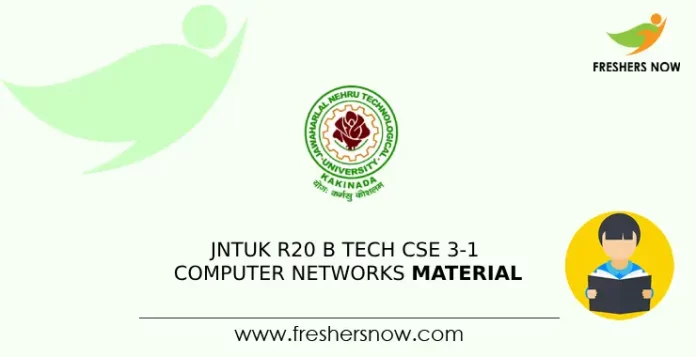
JNTUK R20 B Tech CSE 3-1 Computer Networks Material/ Notes PDF Download: Are you searching for JNTUK R20 B Tech CSE 3-1 Computer Networks study Material. Look here for everything you need! Our collection includes comprehensive notes and materials for JNTUK R20 B Tech Computer Networks, covering all important topics. Whether you need notes or materials in PDF format, we have what you’re looking for. Dive into layered communication architectures like OSI and TCP/IP, learning about their functions and importance in network design. Explore network services, applications, and topologies to enhance your understanding of computer networks. Get ready to excel in your studies with our essential study resources.
JNTUK R20 B Tech CSE 3-1 Computer Networks Material – Units
| No. Of Units | Name of the Unit |
| Unit – 1 | Introduction, Physical Layer |
| Unit – 2 | Data link layer, Sliding window protocol |
| Unit – 3 | Media Access Control, Wired LANs |
| Unit – 4 | The Network Layer Design Issues, Internet Working |
| Unit – 5 | The Transport Layer, Application Layer |
Unit 1 Syllabus PDF Download | JNTUK R20 B Tech CSE Computer Networks Material
Introduction: Network Types, LAN, MAN, WAN, Network Topologies Reference models- The OSI Reference Model- the TCP/IP Reference Model – A Comparison of the OSI and TCP/IP Reference Models, OSI Vs TCP/IP, Lack of OSI models success, Internet History.
Physical Layer: Introduction to Guided Media- Twisted-pair cable, Coaxial cable and Fiber optic cable and unguided media: Wireless-Radio waves, microwaves, infrared.
| JNTUK R20 B Tech CSE 3-1 Computer Networks Material – PDF Download | |
| To Download The JNTUK R20 B Tech CSE 3-1 Computer Networks Unit 1 Notes PDF | Download Reference 1 | Download Reference 2 |
Unit 2 Syllabus PDF Download | JNTUK R20 B Tech CSE Computer Networks Material
Data link layer: Design issues
Framing: fixed size framing, variable size framing, flow control, error control, error detection and correction codes, CRC, Checksum: idea, one’s complement internet checksum, services provided to Network Layer, Elementary Data Link Layer protocols: simplex protocol, Simplex stop and wait, Simplex protocol for Noisy Channel.
Sliding window protocol: One bit, Go back N, Selective repeat-stop and wait protocol, Data link layer in HDLC: configuration and transfer modes, frames, control field, point to point protocol (PPP): framing transition phase, multiplexing, multi-link PPP.
| JNTUK R20 B Tech CSE 3-1 Computer Networks Material – PDF Download | |
| To Download The JNTUK R20 B Tech CSE 3-1 Computer Networks Unit 2 Notes PDF | Download PDF |
Unit 3 Syllabus PDF Download | JNTUK R20 B Tech CSE Computer Networks Material
Media Access Control: Random Access: ALOHA, Carrier sense multiple access (CSMA), CSMA with Collision Detection, CSMA with Collision Avoidance, Controlled Access: Reservation, Polling, Token Passing, Channelization: frequency division multiple Access(FDMA), time division multiple access(TDMA), code division multiple access(CDMA).
Wired LANs: Ethernet, Ethernet Protocol, Standard Ethernet, Fast Ethernet(100 Mbps), Gigabit Ethernet, 10 Gigabit Ethernet.
| JNTUK R20 B Tech CSE 3-1 Computer Networks Material – PDF Download | |
| To Download The JNTUK R20 B Tech CSE 3-1 Computer Networks Unit 3 Notes PDF | Download PDF |
Unit 4 Syllabus PDF Download | JNTUK R20 B Tech CSE Computer Networks Material
The Network Layer Design Issues: Store and Forward Packet Switching-Services Provided to the Transport layer- Implementation of Connectionless Service-Implementation of Connection Oriented Service- Comparison of Virtual Circuit and Datagram Networks, Routing Algorithms-The Optimality principle-Shortest path, Flooding, Distance vector, Link state, Hierarchical, Congestion Control algorithms-General principles of congestion control, Congestion prevention policies, Approaches to Congestion Control-Traffic Aware Routing- Admission Control-Traffic Throttling-Load Shedding. Traffic Control Algorithm-Leaky bucket & Token bucket.
Internet Working: How networks differ- How networks can be connected- Tunnelling, internetwork routing, Fragmentation, network layer in the internet – IP protocols-IP Version 4 protocol-IPV4 Header Format, IP addresses, Class full Addressing, CIDR, NAT-, Subnets-IP Version 6-The main IPV6 header, Transition from IPV4 to IPV6, Comparison of IPV4 & IPV6- Internet control protocols- ICMP-ARPDHCP
| JNTUK R20 B Tech CSE 3-1 Computer Networks Material – PDF Download | |
| To Download The JNTUK R20 B Tech CSE 3-1 Computer Networks Unit 4 Notes PDF | Download PDF |
Unit 5 Syllabus PDF Download | JNTUK R20 B Tech CSE Computer Networks Material
The Transport Layer: Transport layer protocols: Introduction-services- port number-User data gram protocol-User datagram-UDP services-UDP applications-Transmission control protocol: TCP services TCP features- Segment- A TCP connection- windows in TCP- flow control-Error control, Congestion control in TCP.
Application Layer: World Wide Web: HTTP, Electronic mail-Architecture- web-based mail- email security- TELENET-local versus remote Logging-Domain Name System: Name Space, DNS in Internet,- Resolution-Caching- Resource Records- DNS messages- Registrars-security of DNS Name Servers, SNMP.
| JNTUK R20 B Tech CSE 3-1 Computer Networks Material – PDF Download | |
| To Download The JNTUK R20 B Tech CSE 3-1 Computer Networks Unit 5 Notes PDF | Download PDF |
JNTUK R20 B Tech Computer Networks Material – Outcomes
- Explore various network models such as OSI, TCP/IP, B-ISDN, and N-BISDN, each offering different approaches to networking links and communication techniques.
- Examine different transmission media and switching networks, understanding how they facilitate data transfer across networks.
- Investigate data link layer services and protocols like HDLC and PPP, which play crucial roles in ensuring reliable communication between devices.
- Compare and categorize medium access control protocols, including ALOHA, CSMA, CSMA/CD, CSMA/CA, Polling, Token passing, FDMA, TDMA, and CDMA, each with unique methods for accessing and utilizing network resources.
- Determine application layer services and client-server protocols, such as WWW, HTTP, FTP, email, and SNMP, which define interactions between clients and servers in various network environments.
For more details about JNTUK R20 B Tech CSE 3-1 Computer Networks Material and other materials follow our official website Freshersnow.com.



